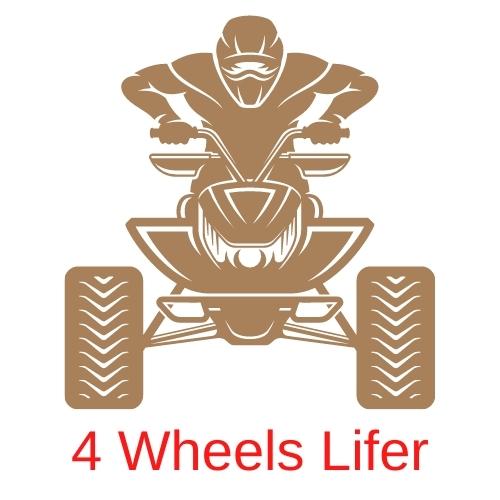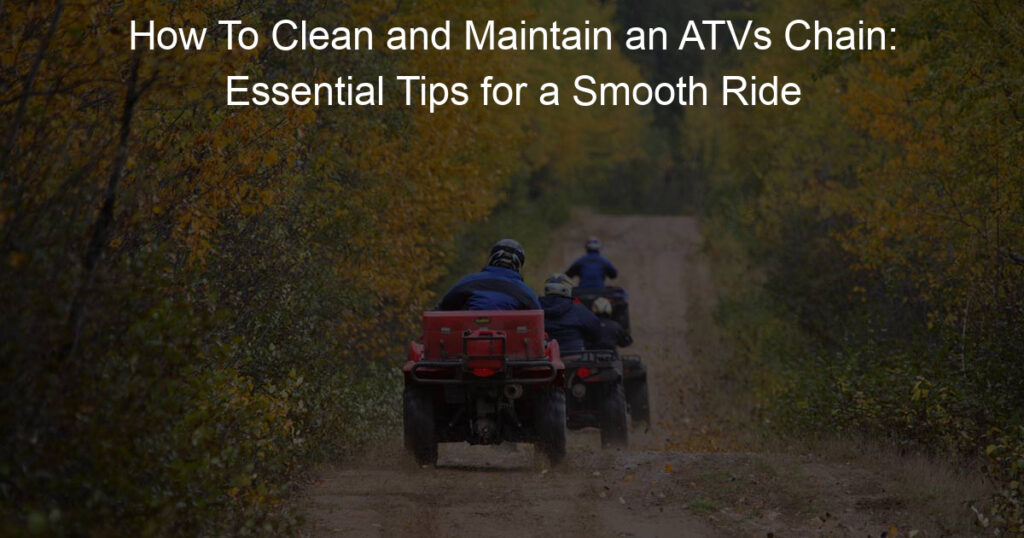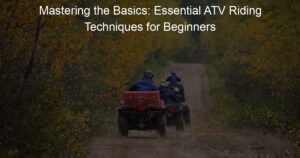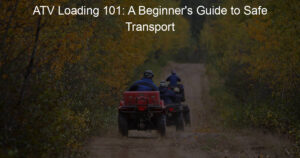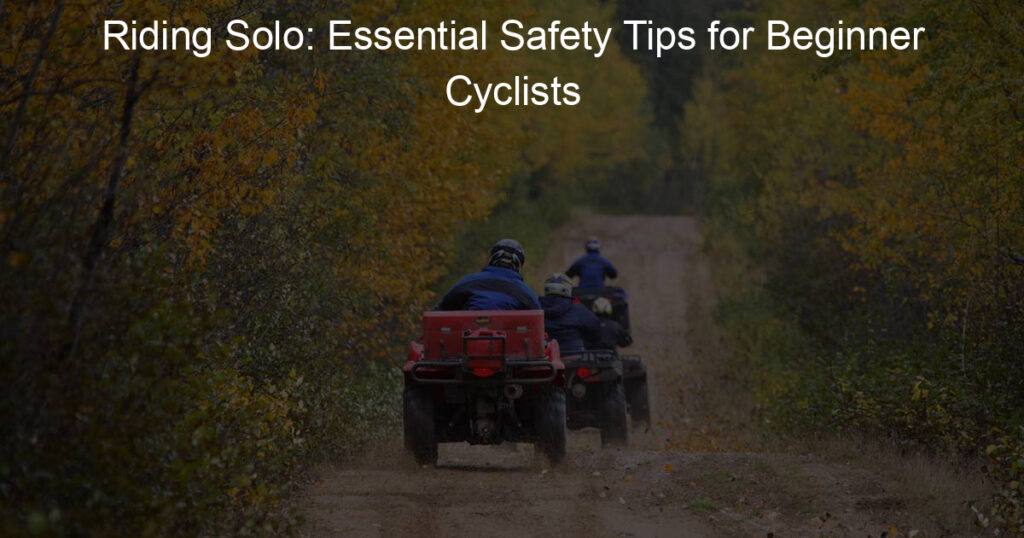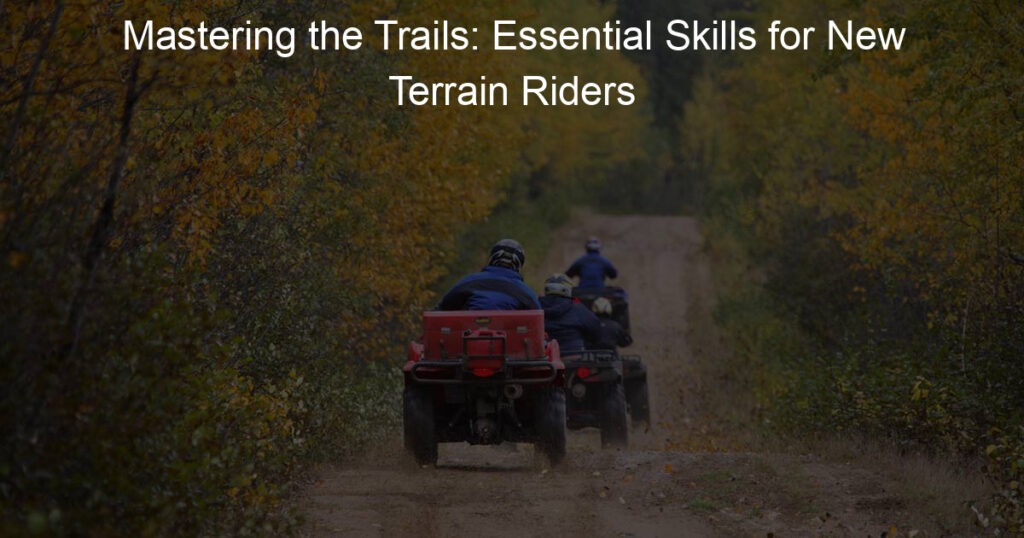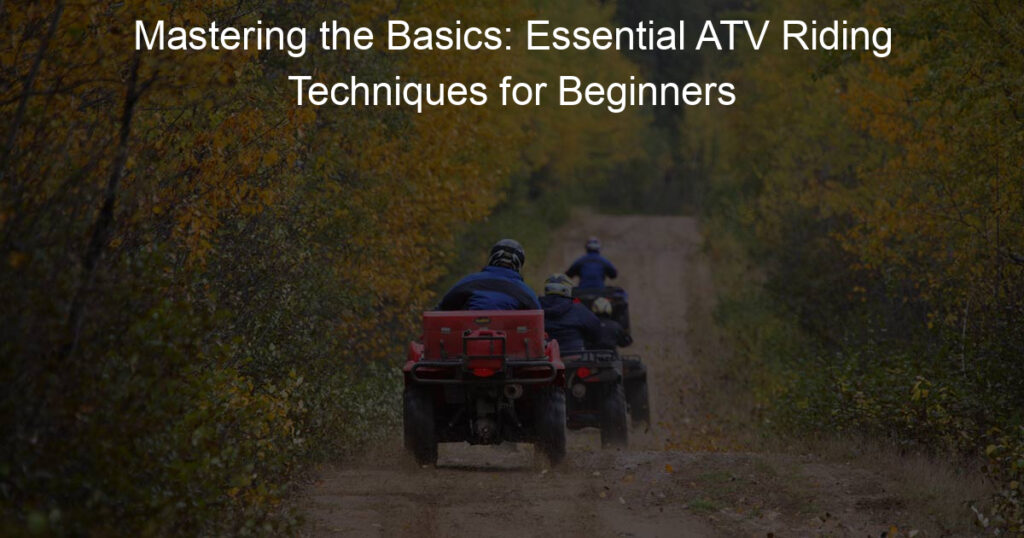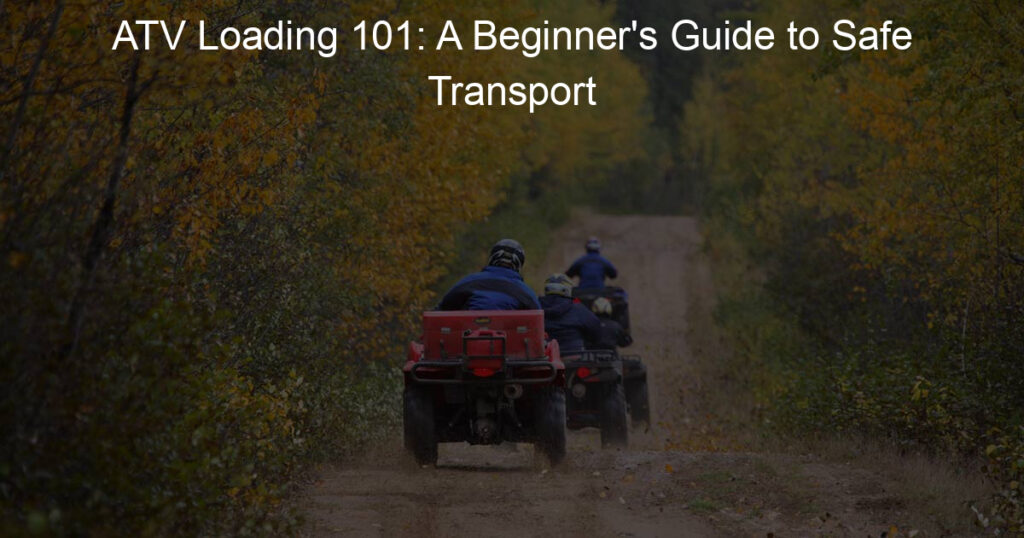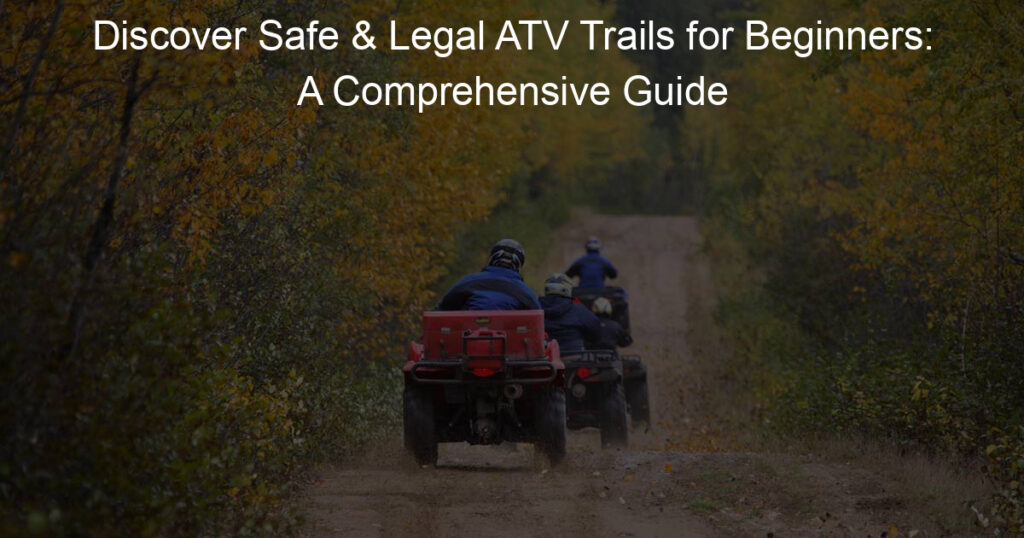As an ATV enthusiast, I know that keeping the chain clean and well-maintained is essential for optimal performance and longevity of our beloved all-terrain vehicles.
It’s easy to overlook this crucial part of regular ATV maintenance, but paying attention to the chain can save you time and money in the long run.
In this article, I’ll share some tips on how to clean and maintain an ATVs chain to ensure smooth rides and prevent unnecessary wear and tear.
First and foremost, it is vital to understand the role of your ATV’s chain and pinpoint the indicators that need some attention.
Don’t worry if you’re not mechanically inclined; I will guide you through the preliminary steps of cleaning and lubing the chain, as well as cover important aspects of sprocket maintenance and ideal chain tension.
Moreover, I’ll touch on essential storage tips and additional maintenance practices to prolong the life of your ATV’s chain. You’ll also find a handy list of frequently asked questions to clarify any doubts you may have.
Now, let’s dive into the world of ATV chain care.
Key Takeaways
- Cleaning and lubricating the chain is crucial for optimal ATV performance
- Sprockets and chain tension play a significant role in chain maintenance
- Proper storage and regular checks enhance the life of your ATV’s chain
How To Clean and Maintain an ATVs Chain
As an ATV owner, I know how important it is to keep my ATV’s chain in good condition. A well-maintained chain not only ensures a smooth ride but also prolongs the life of my ATV.
Before diving into the cleaning and maintenance process, let’s first understand the basics of an ATV chain and its components.
The ATV chain is a crucial component that transmits power from the engine to the wheels. It consists of several interconnected chain links that wrap around the sprockets, allowing the ATV to move.
There are two main types of ATV chains: standard (non-O-ring) and O-ring chains.
Standard Chains: These are basic chains without any additional seals on the links. They tend to be less expensive but require more frequent cleaning and maintenance.
Over time, they may wear out faster compared to O-ring chains due to the lack of protection against dirt and debris.
O-ring Chains: The O-ring chain includes small rubber O-rings between the chain links, which helps to keep dirt out and lubrication in. This additional seal prolongs the chain’s life, but O-ring chains can be slightly more expensive than standard chains and may require special care when cleaning.
Now that we’ve covered the basics of ATV chains, it’s crucial to be aware of the signs that your chain might need cleaning or maintenance. Keeping an eye out for these indicators will help prevent potential damage and ensure a smooth, enjoyable ride on your ATV:
- Check for visible dirt, rust, or any build-up on the chain or sprockets.
- Listen for any unusual noises, such as grinding or squeaking sounds.
- Inspect chain tension, as a loose chain can cause poor performance and damage other components.
By comprehending the different types of ATV chains and being vigilant about potential signs of wear or damage, you can ensure that your ATV stays in top shape.
With the right knowledge and regular care, your ATV chain will function smoothly and efficiently, supporting many more exciting rides in the future.
Preliminary Steps for Cleaning
Safety Measures
Before we begin the process of cleaning and maintaining our ATV’s chain, it’s essential that we take some safety measures. First, let’s make sure to park our ATV on a level surface in a well-lit garage or workspace.
To avoid any accidental movement of the vehicle, it’s a good idea to use a stand or jack stand. For personal safety, I recommend wearing gloves and safety glasses during the cleaning process.
Identifying Necessary Tools
To clean and maintain our ATV chain effectively, we’ll need to gather a few necessary tools.
Here’s a list of items I suggest having on hand:
- A stand or jack stand for securing your ATV
- A chain brush or toothbrush for scrubbing the chain
- A chain cleaner or mild degreaser
- A chain lubricant
- A clean rag for wiping down the chain
- A large pan or container to catch any excess cleaner and debris
By gathering these tools and following the safety measures, we are now prepared to begin the cleaning and maintenance process for our ATV’s chain.
Cleaning the ATV’s Chain
Disassembling the Chain
When I first start cleaning my ATV’s chain, I begin by disassembling it. This is an important step to ensure that all parts of the chain are properly cleaned. To disassemble the chain, I use a chain break tool.
I carefully remove the chain from the dirt bike or ATV, making sure to keep track of any small parts.
Applying the Degreaser
Next, I apply a degreaser to the chain. There are specific degreasers designed for cleaning chains, like chain clean, that work well for this purpose. I spray the degreaser onto the chain, making sure to cover all areas of the chain.
It’s important to let the degreaser sit on the chain for a few minutes, allowing it to break down the grime and dirt.
Removing Grime and Mud
After letting the degreaser sit for a bit, I use a combination of tools to remove the grime and mud from the chain. I find a grunge brush and a regular cleaning brush work well for this.
The grunge brush is great for getting into the tight spaces between the chain links, while the cleaning brush helps to remove dirt from the outer surfaces of the chain.
When using the brushes, I scrub the chain gently, making sure not to damage it.
Once I’ve removed all of the grime and mud from the chain, I rinse it thoroughly with water. Using a garden hose helps to remove any remaining dirt or debris that the brushes missed.
I make sure to rinse the chain until the water runs clear to ensure it’s completely clean.
Following these steps makes my ATV’s chain clean and ready for use. Regular cleaning and maintenance will help my vehicle perform better and keep the chain in good condition longer.
Lubricating Your ATV’s Chain
Choosing the Right Lubricant
There are plenty of lubricants on the market, but it’s essential to find the right one for my ATV’s chain. In general, I look for a high-quality chain lube specifically designed for off-road vehicles.
These lubricants usually contain special additives to resist water, dirt, and extreme temperatures, ensuring proper lubrication throughout my adventures.
I also pay attention to the type of chain on my ATV, as sealed (O-ring, X-ring) and non-sealed chains may require different lubricants. O-ring chains usually call for a lighter lube to avoid damaging the rubber seals, while non-sealed chains can handle a thicker oil.
Applying the Lubricant
Before applying the lubricant, I make sure my ATV’s chain is clean and free from dirt and grime. It’s much easier to lubricate the chain when it’s warm, so I like to go for a short ride before getting started.
Once the chain is warm, I place my ATV on a stand to elevate the wheels off the ground. This allows me to easily rotate the rear wheel and access the full length of the chain. With a rag or brush in hand, I gently clean off any visible dirt or debris.
Now, it’s time to apply the lubricant. I hold the nozzle of the chain lube a few inches away from the chain and spray as I slowly rotate the rear wheel. This ensures I have an even and thorough coat of lubricant on every link of the chain.
After applying the lubricant, I give it some time to penetrate the chain – usually around 15-20 minutes. Finally, I gently wipe off any excess lube with a rag, making sure not to remove too much, as this could cause the chain to become dry and wear prematurely.
By following these steps and using the right lubricant, I’m confident that my ATV’s chain stays in tip-top shape, providing smooth and reliable performance on all my off-road adventures.
Maintaining the Sprockets
Cleaning the Sprockets
I find it essential to keep my ATV’s sprockets clean to ensure a smooth and efficient ride.
Here’s how I go about it:
- Remove any dirt and debris: I use a small brush to remove any mud and dirt that may have accumulated on the sprockets.
- Degrease: After brushing off the larger debris, I apply a degreaser to help break down any grease or grime. I let it sit for a few minutes, then scrub the sprockets with a cloth, ensuring to reaches every nook and cranny.
- Rinse: A thorough rinse with water removes any remaining degreaser and dirt, leaving the sprockets clean and ready for lubrication.
Checking for Wear and Tear
It’s vital that I routinely inspect my ATV’s sprockets for signs of wear and tear.
Here are two key indicators I keep an eye out for:
- Teeth shape: If the sprocket teeth appear to be worn down, hooked, or uneven in any way, it’s time for a replacement. Worn-out teeth can negatively affect chain performance, leading to a decrease in power and a rough ride.
- Rust: I look for signs of rust on the sprockets, as rust can weaken the sprocket material and cause damage to the chain. If my sprockets develop rust, I give them a thorough cleaning and take steps to prevent future rusting.
To sum up, I try my best to maintain my ATV’s sprockets by regularly cleaning them and checking for any potential wear and tear issues. This helps ensure my ATV runs smoothly and performs at its best.
Ensuring Ideal Chain Tension
When maintaining my ATV’s chain, I always prioritize ensuring the ideal chain tension. In my experience, the chain should not be too tight or too loose to prevent any damage and achieve optimal performance.
To check for proper tension, I position my ATV on a flat surface, making sure it’s leveled. Then, I place my finger on the middle of the chain, and gently press down to see if there’s any slack.
A good measure of chain tension is about 1-1.5 inches of movement when pressed.
If I notice that my chain is loose, I start by loosening the axle nuts. After that, I adjust the chain adjusters by turning them clockwise until the desired tension is reached.
While doing this, I maintain the balance between both sides of the wheel to ensure it remains aligned. Once the tension is good, I retighten the axle nuts securely.
On the other hand, if the chain is too tight, it can cause unnecessary strain on the ATV’s components, like the bearings and sprockets. In this case, I loosen the chain by turning the adjusters counterclockwise while ensuring that both sides of the wheel remain aligned.
After achieving the ideal tension, I make sure to retighten the axle nuts.
After adjusting the chain tension, I always take a few moments to inspect the chain’s overall condition. This involves checking for any worn or damaged links, rust, or dirt buildup.
If I spot any issues, I make sure to resolve them promptly to keep my ATV in optimal condition.
By using these simple techniques, I can effectively ensure the ideal chain tension for my ATV’s chain, ultimately prolonging its life and keeping my ride smooth and safe.
ATV Chain Storage Tips
I always make sure to properly store my ATV’s chain to prolong its life and maintain its performance.
Here are some friendly tips I’d like to share with you:
First, it’s important to clean and lubricate the chain before storing it. I usually use a soft-bristle brush and chain cleaner to remove any dirt and then apply a quality chain lube to keep it well-protected.
When it comes to storage, I prefer to keep my chain in a cool, dry location, like my garage or a dedicated storage room in my home. This helps to prevent rust and corrosion. Furthermore, I make sure the area is well-ventilated so that any excess moisture can easily evaporate.
To further protect my chain, I use a chain cover or storage bag. This keeps dust and other debris away from the chain and also prevents it from getting tangled or damaged.
Pro tip: Choose a cover made from a breathable material to avoid trapping moisture inside.
Here’s a quick checklist for you to follow when storing your ATV chain:
- Clean and lubricate the chain
- Store in a cool, dry place
- Keep the area well-ventilated
- Use a chain cover or storage bag
By following these simple tips, I’ve managed to keep my ATV’s chain in great condition, and I hope they’ll help you too!
Additional Tips for ATV Maintenance
Engine and Exhaust Care
As a responsible ATV owner, I always keep an eye on my engine and exhaust systems to ensure they’re in good condition. Regularly checking for any leaks or damage can help prevent accidents and improve performance.
I also use a pressure washer to clean mud and dirt off the engine, but I’m careful with the water pressure to avoid damage. For exhaust maintenance, I like to give it a nice wash and occasionally clean it with WD-40 if needed.
Tire and Suspension Checks
Tire pressure and suspension are essential for a smooth ride on my ATV. I make it a point to check tire pressure before every ride, making sure to adjust it according to the terrain and weather conditions.
I also inspect my quad’s suspension system regularly, looking for any loose or damaged parts that might hinder performance.
Cleaning the Air Filter
Keeping the air filter clean is crucial for my ATV’s engine performance. I usually clean my air filter after every five rides or when I notice it’s getting dirty. I remove the air filter, wash it with warm water and mild detergent, and then apply the filter oil evenly before reinstalling it.
I also make sure to regularly check for any tears or damage that may compromise the filter’s efficiency.
Maintaining the Body and Polishing
I love keeping my ATV looking great and protecting it from dirt and scratches. I wash my quad regularly using a sponge, warm water, and mild soap, making sure to get to those hard-to-reach areas like the swing arm and around the rear wheels.
After washing, I dry my ATV with a clean towel to prevent water spots from forming.
To maintain the shine of my chrome and aluminum parts, I use a high-quality polish. I apply the polish with a soft cloth, buffing it in gently and evenly. This not only keeps my ATV looking fantastic but also prolongs the life of the metal components.
Frequently Asked Questions
What is the best method to clean an ATV chain?
In my experience, the most effective way to clean an ATV chain is to use a soft brush and a chain-cleaning solution. First, I mix some water with the cleaning solution and then gently scrub the chain with the brush.
After cleaning off the dirt and grime, I rinse the chain with water and dry it using a clean cloth.
How often should I lubricate the chain on my ATV?
I usually lubricate my ATV chain every time I go out for a ride or at least once a month if I haven’t been riding regularly. If I’ve ridden through a lot of mud or water, I make sure to clean and lubricate the chain more frequently to keep it in top condition.
What type of chain lube should I use for my ATV?
I recommend using a high-quality, waterproof chain lube specifically designed for ATVs. These types of lubes provide the right balance of protection and performance, ensuring the chain stays well-lubricated and free from rust and corrosion.
Is it necessary to remove the chain for thorough cleaning?
I find that removing the chain from my ATV allows me to do a more thorough cleaning job. By taking it off, I can better inspect the chain for wear and damage, as well as make sure all of its parts are properly cleaned and lubricated.
Nevertheless, if you’re short on time or don’t have the necessary tools, you can still clean the chain reasonably well while it’s on the ATV.
How can I prevent rust on my ATV chain?
To prevent rust on my ATV chain, I make sure to clean and lubricate it regularly, especially after riding in wet or muddy conditions. I also apply a layer of anti-corrosion spray to protect the chain from moisture and the elements.
What are some signs that my ATV chain needs replacing?
Some signs that my ATV chain may need replacing include excessive stretching, tight links, or excessive wear on the sprockets. If I notice any of these signs, I consult my ATV’s owner’s manual for guidelines on when to replace the chain and follow the recommended maintenance schedule.
